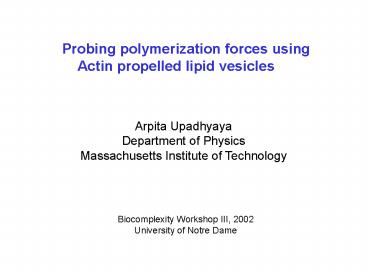Probing polymerization forces using PowerPoint PPT Presentation
1 / 29
Title: Probing polymerization forces using
1
Probing polymerization forces using Actin
propelled lipid vesicles
Arpita Upadhyaya Department of Physics Massachuset
ts Institute of Technology
Biocomplexity Workshop III, 2002 University of
Notre Dame
2
Cells in motion
How do cells move around ?
3
Crawling of most cells is based on actin
keratocyte
labeled actin
4
Actin Polymerization
Spontaneous addition of monomers to produce
polymer filament.
Plus end
Minus end
5
The polymerization motor
How can polymerization push ?
Thermal fluctuations are important
Brownian ratchet model Peskin, Odell and Oster
Elastic Brownian ratchet
Oster and Mogilner
However, a single filament is too weak
6
Experimental systems to explore force generation
by actin polymerization
- Biochemically very complex - Biophysical
properties are hard to quantify
Eukaryotic cells(e.g neutrophils)
- Biochemically well defined - Biophysical
properties are easier to measure
Prokaryotic pathogens(e.g Listeria monocytogenes)
Loisel, Boujemaa, Pantaloni Carlier. Nature
401, 613 (1999).Cameron, Giardini, Soo
Theriot, Nature Rev. Mol. Cell Biol. 1, 110
(2000).
7
The bacterial pathogen Listeria
5 ?m
(Julie Theriot)
5 ?m
Listeria monocytogenes propels itself through the
cytoplasm of a host cell by polymerizing actin in
its wake
8
Motility in-vitro ActA Arp2/3
complex Actin Cytoplasmic extract
9
Listeria
Lamellipodium
10
The spherical Listeria ActA coated beads
(Cameron et al.)
11
The spherical Listeria ActA coated beads
(Cameron et al. van Oudenaarden et al.)
12
Experimental systems to explore force generation
by actin polymerization
- Biochemically very complex - Biophysical
properties are hard to quantify
Eukaryotic cells(e.g neutrophils)
- Biochemically well defined - Biophysical
properties are easier to measure
Prokaryotic pathogens(e.g Listeria monocytogenes)
- - Biochemically well defined
- Biophysical properties are easier to measure
- Biochemical and biophysical properties can
- be changed
ActA coated beads
13
Why lipid vesicles
- Lipid vesicles deform under external loads
- Shapes can be used to measure forces
- Fluid under shear, but can bend and stretch
Microtubules polymerizing inside vesicles
(Fygenson et al.)
14
Our biophysical model system Synthetic
phospholipid vesicles coated with ActA
tethers
vesicles
Fluorescence (red actin, green lipids)
DIC
15
Actin driven self-organization of lipid vesicles
16
Branching of tethers
Vesicles can make sharp turns
C
17
ActA - vesicles as biophysical model systems for
force generation by actin
- Close similarity to real cells
- Tunable size
- Tunable lipid and membrane protein composition
- Tunable physical properties (e.g. elastic
moduli) - Controllable biochemistry
But most importantly, Being flexible, they
enable a quantitative measurement of the forces
18
actinlipid
lipid
actin
5 ?m
19
Spontaneous polarization of ActA
2 ?m
Phase contrast
Fluorescent ActA (cys-mutant)
20
Vesicle deformation Energetics
A
Ao
V
Vo
actin pressure
free vesicle (rest area Ao, rest
volume Vo)
vesicle deformed by actin (area A gt Ao, volume V
lt Vo)
0
membrane stretching
osmotic pressure
21
Polymerization induced stresses
Osmotic Pressure
Global, outward
Stress from stretching
Local, inward
Tension
Stress depends on the difference in curvatures
22
Actin can pull and push
squeezing forces
retractile forces
S
T
S
2 ?m
Actin stress
23
How to calculate deformation of a vesicle ?
membrane displacement
polymerization velocity
stresses (forces/area)
global pressure
local stretching depends on local curvatures
?1 ?2
Parameters Stretching modulus K
Initial Concentation Co
24
Probing polymerization forces
0
4
140
nN/?m2
0
200
actin pressure (nN/?m2)
240
-4
T
S
S
coordinate along membrane interface
280
25
Stepping motion of vesicles
5 ?m
Distance (?m)
Slow phase alternates with fast phase.
Time (s)
26
Actin must bind to the vesicle
Vtrailing
?/min
?/min
Vleading
Aspect ratio
Time (s)
27
Stepping of a model vesicle
4
nN/?m2
0
-4
28
Actin driven motion conclusions
- Actin exerts retractile and propulsive forces
on vesicles. - Flexible vesicles exhibit stepping motility.
- Actin is strongly bound to membrane.
- Importance of membrane mechanical properties in
determining forces exerted by actin relevance
to real cells. - Mimic the biochemistry of the lamellipodium
29
ACKNOWLEDGMENTS
Alexander van Oudenaarden Jeff Chabot Albina
Andreeva
Funding Dupont/MIT Alliance Pappalardo
Foundation

